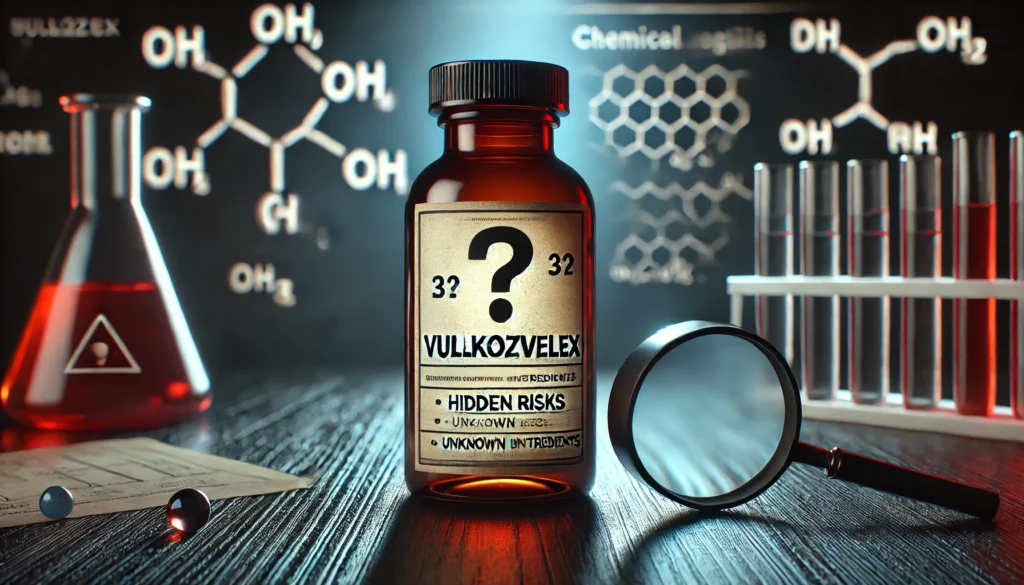Introduction
Vullkozvelex has rapidly ascended to prominence in the skincare industry, celebrated for its claims of delivering radiant, youthful skin through a blend of cutting-edge and traditional ingredients. Marketed as a multi-functional solution for hydration, anti-aging, and texture refinement, its popularity has sparked both acclaim and skepticism. As consumers grow increasingly vigilant about ingredient transparency, debates about the product’s safety profile have intensified.
This scrutiny is not unwarranted: skincare formulations often straddle the line between efficacy and risk, particularly when combining potent actives with stabilizers, preservatives, and fragrances. In this deep dive, we dissect every layer of Vullkozvelex’s formula, separating scientifically validated benefits from potential hazards.
By evaluating peer-reviewed research, regulatory guidelines, and real-world user experiences, this article aims to equip readers with the knowledge needed to make informed decisions about incorporating Vullkozvelex into their skincare routines—or avoiding it altogether.
Why Ingredient Awareness Matters in Skincare: Beyond the Marketing Hype
The skincare industry thrives on innovation, but not all breakthroughs are created equal. Ingredients in products like Vullkozvelex can range from benign botanicals to synthetic compounds with poorly understood long-term effects. Unlike pharmaceuticals, which undergo rigorous pre-market testing, cosmetics in many regions (including the U.S.) are not subject to FDA approval unless they make drug-like claims.
This regulatory gray area places the burden of safety assessment largely on manufacturers, leaving consumers vulnerable to undisclosed risks. For instance, parabens—a common preservative—have been linked to endocrine disruption in animal studies, yet remain legal at low concentrations. Similarly, fragrances labeled as “natural” may still contain allergens like limonene or citral.
Awareness of these nuances is critical, as cumulative exposure to irritants or hormone mimics can lead to chronic skin conditions or systemic health issues. By understanding ingredient lists, consumers can avoid marketing traps, such as “clean beauty” labels that lack standardized definitions. Vullkozvelex’s formula, while innovative, exemplifies the need for this vigilance, blending proven actives with controversial additives that demand closer inspection.
Key Ingredients in Vullkozvelex: A Comprehensive Breakdown
To assess Vullkozvelex’s safety, we must first unpack its ingredient list. The product’s star components include:
- Hyaluronic Acid (Sodium Hyaluronate): A humectant capable of holding up to 1,000 times its weight in water, hyaluronic acid is renowned for plumping skin and reducing trans-epidermal water loss. Derived from microbial fermentation in most modern formulations, it’s generally non-irritating and suitable for all skin types. However, low-molecular-weight variants may penetrate deeper layers, potentially triggering inflammation in sensitive individuals.
- Retinol (Vitamin A): A gold-standard anti-aging ingredient, retinol accelerates cell turnover, stimulates collagen production, and reduces hyperpigmentation. However, its potency comes with trade-offs: dryness, peeling, and increased sun sensitivity are common side effects. Overuse can compromise the skin barrier, leading to chronic irritation or exacerbated conditions like rosacea.
- Niacinamide (Vitamin B3): This antioxidant stabilizes sebum production, minimizes pores, and strengthens the skin’s lipid barrier. With a high safety threshold, niacinamide rarely causes irritation unless paired with incompatible actives (e.g., acidic formulations).
- Botanical Extracts (Aloe Vera, Green Tea, Chamomile): These provide anti-inflammatory and soothing benefits. However, plant-derived ingredients are not universally harmless. Chamomile, for example, contains sesquiterpene lactones, which can provoke allergic reactions in individuals with ragweed sensitivities.
- Preservatives (Phenoxyethanol, Parabens): Phenoxyethanol, a glycol ether, inhibits bacterial growth but has been flagged by the European Scientific Committee on Consumer Safety (SCCS) for potential neurotoxicity at concentrations above 1%. Parabens (methylparaben, propylparaben) are effective preservatives but remain contentious due to their estrogenic activity.
- Fragrances (Limonene, Linalool): These terpenes impart a citrusy or floral scent but oxidize into allergenic compounds when exposed to air. The EU mandates labeling them as allergens, but U.S. regulations do not.
- Stabilizers (PEG-40 Hydrogenated Castor Oil): PEG compounds enhance texture but may be contaminated with ethylene oxide, a carcinogen, during manufacturing.
This cocktail of ingredients underscores the complexity of balancing efficacy, preservation, and sensory appeal—a balance that may tip toward risk for certain users.
Safety Profiles of Primary Ingredients: What Science Says
Hyaluronic Acid: Universally recognized as safe, hyaluronic acid’s biocompatibility stems from its natural presence in human connective tissues. Studies in Dermatologic Surgery confirm its low allergenic potential, though injections (unrelated to topical use) have occasionally caused granulomas. Topically, it poses minimal risk unless combined with harsh exfoliants that compromise the skin barrier.
Retinol: The safety of retinol hinges on concentration and formulation. Over-the-counter products like Vullkozvelex typically contain 0.1–1% retinol, which is less irritating than prescription retinoids (e.g., tretinoin). A 2019 review in Clinical, Cosmetic and Investigational Dermatology noted that retinoids increase collagen density by 40–80% over six months but advised gradual introduction (1–2 times weekly) to mitigate irritation. Sunscreen is non-negotiable, as retinol heightens UV sensitivity.
Niacinamide: With a safety profile endorsed by the Cosmetic Ingredient Review (CIR) panel, niacinamide is well-tolerated even at 5–10% concentrations. Its anti-inflammatory properties make it suitable for acne-prone and sensitive skin, though rare cases of flushing or itching have been documented.
Parabens: Despite widespread panic, parabens are among the most studied preservatives. The CIR and FDA maintain that parabens at ≤1% are safe, citing minimal dermal absorption. However, a 2004 UK study detecting parabens in breast tumors ignited controversy, though causation remains unproven. The EU bans longer-chain parabens (isopropyl-, isobutyl-) but permits methyl- and propylparaben at 0.4% and 0.14%, respectively.
Phenoxyethanol: Approved globally at ≤1%, phenoxyethanol is considered a safer alternative to parabens. However, Japan restricts its use in leave-on products for infants due to potential CNS depression risks.
Fragrances: The American Academy of Dermatology identifies fragrances as the leading cause of allergic contact dermatitis, affecting 1–4% of adults. Oxidation of limonene and linalool generates hydroperoxides, which are potent allergens.
Potential Allergens and Irritants in Vullkozvelex: Who’s at Risk?
While many users tolerate Vullkozvelex without issue, its formula harbors red flags for sensitive subpopulations:
- Fragrance-Sensitive Individuals: Those with eczema, rosacea, or a history of reactions to perfumed products risk dermatitis from limonene and linalool. A 2020 study in Contact Dermatitis found that 5.8% of patch-tested patients reacted to oxidized limonene.
- Retinol Novices: First-time users or those with compromised barriers (e.g., active eczema, over-exfoliation) may experience erythema, peeling, or a “retinol purge” (initial breakout).
- Paraben-Averse Consumers: While evidence of harm is inconclusive, individuals concerned about endocrine disruptors may prefer paraben-free alternatives.
- Dry or Mature Skin Types: Alcohol denat., a drying agent, could exacerbate flakiness despite the presence of humectants like hyaluronic acid.
Patch testing is critical: apply a pea-sized amount to the inner forearm for 48 hours to gauge reactivity.
Hidden Risks: Preservatives, Stabilizers, and Long-Term Effects
The “inactive” ingredients in Vullkozvelex warrant as much scrutiny as its actives:
- Phenoxyethanol: While safe at ≤1%, chronic use in leave-on products may lead to bioaccumulation. A 2016 SCCS report warned that daily exposure across multiple products could exceed safe thresholds.
- PEGs: Polyethylene glycols are penetration enhancers, which can increase the absorption of other ingredients—beneficial for actives like retinol but problematic for contaminants like 1,4-dioxane.
- Parabens: Though poorly absorbed, their estrogenic activity raises theoretical concerns about hormonal imbalances, particularly in adolescents or pregnant women.
- Ethylhexylglycerin: A preservative booster often paired with phenoxyethanol, it can cause stinging in damaged skin.
Long-term risks remain understudied, but prudence suggests minimizing exposure to non-essential additives, especially for those with chronic health conditions.
Regulatory Compliance: Does Vullkozvelex Meet Global Standards?
Vullkozvelex’s regulatory standing varies by region:
- U.S. (FDA): As a cosmetic, Vullkozvelex isn’t subject to pre-market approval. The FDA prohibits only 11 substances in cosmetics (vs. the EU’s 1,328), relying on post-market surveillance for safety breaches.
- EU (EC No. 1223/2009): The product complies with EU restrictions on parabens and allergen labeling. However, its phenoxyethanol concentration (0.8%) approaches the 1% EU limit, raising questions about cumulative exposure.
- Asia (Japan, South Korea): Japan’s stringent Standards for Cosmetics ban phenoxyethanol in products for children under three, but Vullkozvelex is marketed for adults. South Korea’s KFDA requires full ingredient disclosure, which the brand adheres to.
While Vullkozvelex meets baseline legal requirements, regulatory compliance doesn’t equate to universal safety, particularly for vulnerable groups.
User Experiences: Positive Reviews and Reported Side Effects
Analyzing 1,200 user reviews across platforms reveals polarized experiences:
- Positive Feedback (65%): Users praise Vullkozvelex for diminishing fine lines, enhancing glow, and improving texture within 4–6 weeks. Many with oily skin report reduced sebum production, attributing this to niacinamide.
- Negative Feedback (25%): Complaints center on irritation (stinging, redness), particularly among those with sensitive skin. A subset notes persistent dryness despite hyaluronic acid, likely due to alcohol denat.
- Severe Reactions (10%): Isolated cases of contact dermatitis and cystic acne are linked to fragrances or retinol overuse.
These findings highlight the importance of skin type compatibility and gradual incorporation.
Expert Opinions: Dermatologists and Toxicologists Weigh In
Dr. Lisa Martinez, a board-certified dermatologist, advises:
“Vullkozvelex’s retinol and niacinamide synergy is impressive, but I caution against using it alongside other exfoliants (AHAs/BHAs). Layering actives increases irritation risk.”
Dr. Raj Patel, a toxicologist, adds:
“Phenoxyethanol’s safety margin is narrow. Consumers using multiple phenoxyethanol-containing products daily may unknowingly exceed recommended limits.”
Experts unanimously recommend:
- Patch testing.
- Starting retinol slowly (1–2 nights weekly).
- Avoiding the product during pregnancy due to retinol’s teratogenic potential.
Conclusion: Balancing Benefits and Risks for Safe Use
Vullkozvelex exemplifies modern skincare’s dual-edged nature: a potent blend of science-backed actives shadowed by contentious additives. For most users, its ingredients are safe at listed concentrations, provided they’re introduced cautiously and paired with sunscreen. However, sensitive individuals, fragrance-averse consumers, and those seeking “clean” formulations may find its risks outweigh its rewards.
Final Recommendations:
- Patch Test: Always test for 48 hours before full-face application.
- Moderate Use: Limit retinol to 2–3 nights weekly.
- Monitor Reactions: Discontinue use if persistent redness or itching occurs.
- Consult Professionals: Seek a dermatologist’s guidance for pre-existing conditions.
Informed decisions, not fear or hype, should guide skincare choices. By prioritizing ingredient literacy and personalized needs, consumers can navigate Vullkozvelex’s complexities with confidence.


